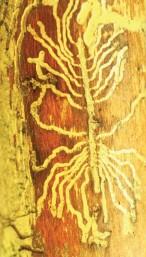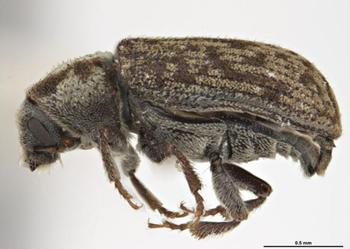Douglas-fir Pole Beetle (Pseudohylesinus nebulosus)
Trees Affected
Common: Douglas-fir
Occasional: None
Summary
The Douglas-fir pole beetle is a small (~1/8” long) beetle that attacks small diameter trees or branches and makes larval galleries in their host’s cambial layer (under the bark). These beetles tend to mate in early spring, and are generally more active in trees that are already experiencing stress such as drought or attacks from more aggressive pests or pathogens. Trees that have been attacked by the Douglas-fir pole beetle show classic crown symptoms of beetle attack, including rapid individual branch, top, or whole tree decline and red needles in the affected area/s. Exit holes (smaller than the diameter of a grain of rice) may be present on the trunk or branches, and reddish-brown boring material may persist on the outside surface of the bark. One of the more reliable ways to distinguish between this and other bark beetles such as the Douglas-fir engraver beetle is to examine the larval galleries. The Douglas-fir pole beetle makes a one to three inch long main gallery that is aligned with the grain of the wood, with thin larval chambers coming off along the upper and lower portion of the main gallery. The beetle itself is covered in dull tan and brown scales, and is loosely oval-shaped.
Local Distribution


Unknown, but native throughout the North Coast.
Management Strategies
This beetle is a secondary stressor and is unlikely to kill healthy trees. Therefore, the best management strategy is to promote tree health by thinning, controlling other pathogens such as root disease, and avoiding general stress where possible. Being aware that drought can reduce tree vigor and resin production may also help in planning for upticks in beetle-related mortality post-drought.
Pests and Pathogens with Similar Symptoms
Douglas-fir Engraver Beetle (Scolytus unispinosus): This beetle causes the same kinds of crown symptoms and can be managed the same way. However, if you’re curious about which one you have, take a look at the larval galleries under the wood and read about the differences in gallery styles here.
Douglas-fir Beetle (Dendroctonus pseudotsugae): This beetle causes similar crown symptoms but can kill large, healthy trees. Additional signs and symptoms of this beetle include orangish boring material in bark crevices and (sometimes, depending on tree vigor) pitching along the trunk.The most definitive way to distinguish this beetle from others is by the organization of its larval galleries, which is compared to common, less aggressive Douglas-fir inhabiting beetles here.
Flatheaded Fir Borer (Phaenops drummondii): This beetle causes similar crown symptoms but can kill large, healthy trees. However, unlike other beetles listed here, the flatheaded fir borer makes 1/8” to 1/4” oval-shaped exit holes without boring dust. Additionally, the flatheaded fir borer does not make galleries in the wood like bark beetles do. Instead, the larvae of these beetles make pupal chambers on the inner side of their host’s bark.
Further Reading
Differences between Douglas-fir pole beetle and Douglas-fir engraver beetle and management strategies:
https://www.oregon.gov/ODF/Documents/ForestBenefits/DF%20Pole%20and%20Engraver_2017.pdf
Differences between Douglas-fir pole beetle, Douglas-fir engraver beetle, and Douglas-fir beetle:
Evaluating tree status during/after a beetle attack:

